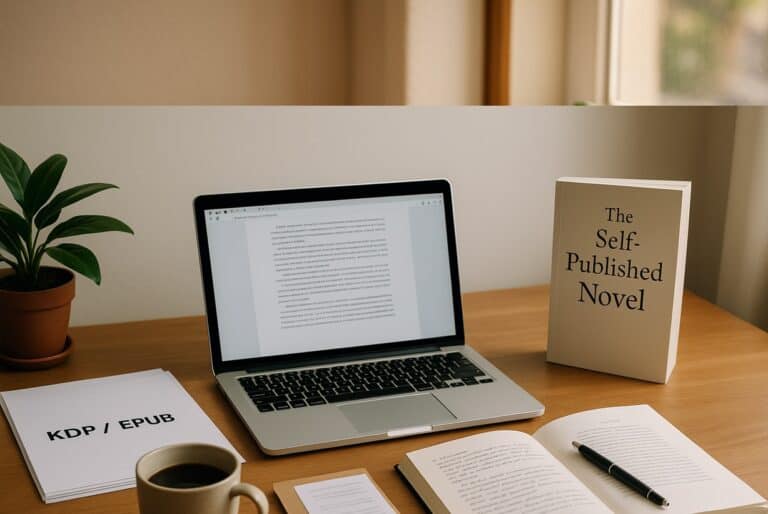Planned Breaks: 4 Tips to Transform Your Writing Journey

Discover how planned breaks can supercharge your creativity and productivity as a new author. Explore the science behind how breaks boost your writing skills. Learn how to transform your writing routine.
“Almost everything will work again if you unplug it for a few minutes, including you.” – Anne Lamott
The creative engine of a writer thrives on rhythm and momentum, but even the most dedicated authors find themselves needing to hit the pause button occasionally. Whether you’re a first-time author or a creative soul testing the waters of digital writing, you’ll benefit from learning the art of planned breaks to unlock new levels of creativity and efficiency in your writing journey.
It’s during these precious intervals of rest and relaxation when we often stumble upon our most illuminating insights, breathing fresh life into our work. Embracing the art of the break could well be the secret to heightened productivity and creativity, even for new authors.
In this guide, we delve into the world of strategic break-taking. You’ll find strategies for harnessing its power to revolutionize your creativity and writing productivity.
The Power of a Break: Why Pausing Boosts Creativity
According to research from Stanford University, going for a walk in nature can lead to a 60% increase in creative output. While the stimulation of the outdoor environment certainly plays a role, the fundamental principle remains the same: taking a break from focused work frees up cognitive resources, allowing for an influx of fresh ideas and perspectives.
The concept of a break is nothing novel. It’s as essential to our cognitive functioning as sleep is to our physical well-being. It may seem counterintuitive for you as a new author who is eager to fill pages and build your writing portfolio. But strategically timed breaks can act as a catalyst for your creativity.
The human brain is an incredible machine, capable of extraordinary feats of creativity and problem-solving. However, just like any complex system, it requires regular periods of rest to function at its optimum level. This is particularly true for new authors who are often caught in a whirlwind of ideas, expectations, and the relentless urge to put pen to paper.
When you embark on the writing journey, the initial excitement often masks the need for breaks. The enthusiasm to craft a captivating narrative or the pressure to meet self-imposed deadlines may push breaks to the backseat. However, succumbing to this non-stop momentum can be counterproductive, leading to burnout, reduced creativity, and sub-par output.
Recently, I reminded a new author to take periodic breaks just as he was required to do when he worked for a large company. The following month, he told me he wished he had listened to my advice. He was suffering from a lack of motivation and was on the brink of burnout. Of course, we then talked about ways to get back on track with his writing (but getting back on track is a different topic).
It’s crucial to understand that taking a break isn’t about escaping work but about enhancing it. Think of it as a mental intermission during an intense theatrical performance. During this period, the brain reorganizes thoughts, consolidates memories, and reinforces learning, much like tidying up a cluttered desk or organizing a chaotic workspace.
Recognize the power of a break and incorporate it into your writing routines. Doing so will serve to recharge your cognitive batteries, stimulate creative thinking, and ultimately, contribute to producing high-quality, engaging content you aspire to create. It’s about stepping back to leap forward, a concept that sits at the heart of any successful creative endeavor.
Once, during a tedious project, a co-author of mine decided to take a break, only to return with a quirky plot twist. It turned the narrative on its head. It was fascinating to see how a few moments of distance from the task injected fresh perspective into the story. Breaks, as we discovered, act as mental pit stops, refueling our creative energy.
Breaks & the Creative Process: An Unlikely Alliance
Scientists from the University of Illinois at Urbana-Champaign found that brief diversions vastly improve focus, providing a fresh start upon returning to a task. Just as muscles tire with constant use, our brain, too, needs a breather to recharge and refocus. It’s crucial for new authors to understand that creativity is not a faucet you can simply turn on and off. It’s more akin to a stream, flowing freely at times and trickling at others. Breaks help regulate this flow, aiding in the generation of innovative ideas.
Understanding this unlikely alliance can be transformative when you’re often grappling with your creative rhythms and working out your unique writing style.
The process of writing is a cognitive symphony. It involves various aspects of the brain, from memory and language processing to creativity and emotion regulation. Constant engagement in this brain activity without breaks can lead to cognitive fatigue, diminishing the quality of output and stifling creative flow.
On the other hand, taking a planned break does wonders for rejuvenating the mind. During periods of rest, the brain enters a state called the “default mode network” (DMN), a phase of heightened internal focus and reduced attention to the external environment. It’s within this state that our most creative ideas often emerge, as the mind freely wanders, exploring uncharted territories of thought.
Consider the case of renowned author, Neil Gaiman, who has often spoken about how his best ideas come to him during “downtime,” while taking long walks or soaking in the bath. In fact, Gaiman goes as far as to deliberately engineer boredom into his routine to kindle his imagination.
For a new author, integrating strategic breaks into your writing schedule isn’t a luxury–it’s a necessity. The goal is to create space for the mind to breathe, reenergize, and foster the DMN state, catalyzing the creative process.
By adopting this alliance between breaks and creativity, you can not only stave off fatigue and burnout but also enhance your imaginative capacities, leading to more engaging narratives, compelling characters, and richer plot developments. It’s about creating a writing rhythm that marries productivity with sustainability, enabling you to consistently produce your best work.
Top of Form
The Art of Strategic Break-Taking: Unleashing Your Creativity
While the benefits of breaks are clear, mastering the art of strategic break-taking is a game-changer in unleashing the full potential of your creativity. This involves a deliberate and thoughtful approach to incorporating breaks into a writing routine, and while it may initially appear challenging, it’s an essential skill.
Strategic break-taking is not about indiscriminately pausing work whenever one feels like it, but about understanding the rhythms of your own mind and body and scheduling breaks to optimize those rhythms. Everyone’s internal clock, known scientifically as the “circadian rhythm,” operates differently. Some authors might find their creative juices flowing incessantly in the early hours of the morning, while others may hit their stride in the tranquility of the late evening.
Research has shown that most people work optimally in periods of focused activity lasting around 90 to 120 minutes, known as “ultradian cycles.” After this, taking a break can reset the cycle, allowing for another burst of productive activity. This is the principle behind techniques such as the Pomodoro Technique, which advocates for 25-minute work periods followed by short, five-minute breaks. This can maintain your energy levels and prevent burnout.
For a new author, developing an understanding of your unique ultradian rhythms and aligning your writing and break schedules to these rhythms can significantly boost creativity and productivity. It can transform the writing process from a battle against the clock into a harmonious dance with time.
Strategic break-taking also involves the nature of the break itself. Engaging in activities that are diametrically different from writing during a break can refresh the mind more effectively. Make the break enjoyable. It should be something you look forward to. Enjoy a cup of coffee, take a leisurely walk, read a chapter of a book, or take a short nap. A break could involve anything from physical exercise, meditation, or listening to music, to a simple stretch or more passive activities such as daydreaming.
Use this time to disengage from your work entirely. Disconnect completely. Avoid the temptation to brainstorm or problem-solve during this time.
Strategic break-taking is a highly personal and customizable practice. You can experiment with different lengths, frequencies, and types of breaks to see what best sparks your creativity and maintains your writing momentum.
Adopting this approach enables you to make the most of each writing session, enhancing the quality of your work and making the writing journey more sustainable and enjoyable. As you master the art of planned breaks, you’ll find it not only fuels creativity but also brings a newfound appreciation for the rhythm of your own writing life.
Conclusion
Breaks are not distractions but rather vital tools that can enhance creativity and productivity. For a new author, embracing the art of the planned break can be transformative. Start shifting the narrative from viewing breaks as setbacks to appreciating them as opportunities for inspiration and rejuvenation in your writing journey. Harness planned breaks for better writing output. Take a break and let your creativity flourish.
We hope you have found the tips for taking planned breaks helpful and inspiring. We’re excited to continue this journey with you, providing guidance and encouragement every step of the way.
Don’t wait. Start today!
How can we help? To let us know, please fill out our contact form. Happy writing!
FAQs
Do longer breaks lead to greater creativity?
Not necessarily. It’s about the quality of the break, not the length. Short, regular breaks can be more beneficial than infrequent, long ones.
I’m not feeling tired or burned out. Should I still take a break?
Yes, breaks can still enhance creativity and productivity even if you’re not feeling tired. They provide a change of scenery and perspective.
Should I take breaks even when I’m on a roll with my writing?
While it can be tempting to skip breaks when you’re in the ‘zone’, even short pauses can help maintain your momentum longer.
I’m on a tight deadline. Can I afford to take breaks?
Even under tight deadlines, breaks can improve the quality of your work and prevent errors. It’s a matter of working smarter, not harder.
What should I avoid during my breaks?
Try to avoid screens during your breaks. Physical activity or relaxation exercises are generally more beneficial.

